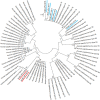Detection of human papillomavirus genotypes, herpes simplex, varicella zoster and cytomegalovirus in breast cancer patients
- PMID: 33482849
- PMCID: PMC7821692
- DOI: 10.1186/s12985-021-01498-z
Detection of human papillomavirus genotypes, herpes simplex, varicella zoster and cytomegalovirus in breast cancer patients
Abstract
Background: The role of viruses as a cause of breast cancer (BC) has been significantly investigated in recent years. Human papillomavirus (HPV) has been detected in invasive breast carcinomas, while most studies have only focused on the detection of viral DNA, we aimed to examine the prevalence and genotypes of HPV among Iranian BC patients. We also examined the presence of herpes simplex-1 (HSV-1), herpes simplex-2 (HSV-2), varicella zoster virus (VZV), and cytomegalovirus (CMV) in these samples.
Methods: We collected and analyzed 70 Formalin-Fixed Paraffin-Embedded (FFPE) blocks including 59 BC samples, and 11 benign breast lesions as control from Iranian patients using nested PCR. Real-time PCR utilized as a confirming test to nested PCR findings. Genotyping of HPV positive samples was performed, the samples were also subjected to a multiplex PCR to detect HSV-1, HSV-2, VZV, and CMV in BC.
Results: Papillomavirus DNA was present in 7 of 59 BC samples (11.8%); while none was detected in control samples. The most prevalent type was HPV18, followed by HPV 6. All HPV positive patients had high tumor grades (II/ III) with a histologic diagnosis of ductal carcinoma. The patient age range was 33 to 73 years with a median of 51 years. Most of HPV positive patients had low levels of education. HPV16 was not detected. Also, 5 of 59 BC specimens (8.47%), were positive for HSV-1. But none of the samples were positive for HSV-2, VZV, and CMV.
Conclusions: Our results suggest a carcinogenesis role for High-risk HPV (HPV18) in breast tumors. Our findings of HSV-1 and low-risk HPV (HPV6) in BCs may propose a cancer-causing role for them. Further large-scale studies are warranted to assess the significance of our findings.
Keywords: Breast cancer; Genotype; HPV; Herpes virus; Human papillomavirus; PCR.
Conflict of interest statement
The authors declare that they have no competing interests.
Figures




Similar articles
-
Multiplex polymerase chain reaction for the detection of herpes simplex virus, varicella-zoster virus and cytomegalovirus in ocular specimens.Curr Eye Res. 2003 Aug;27(2):85-90. doi: 10.1076/ceyr.27.2.85.15947. Curr Eye Res. 2003. PMID: 14632159
-
Detection of herpes simplex virus type 1, herpes simplex virus type 2 and varicella-zoster virus in skin lesions. Comparison of real-time PCR, nested PCR and virus isolation.J Clin Virol. 2004 Feb;29(2):120-6. doi: 10.1016/s1386-6532(03)00113-6. J Clin Virol. 2004. PMID: 14747031
-
The diagnostic significance of enzyme linked immuno-sorbent assay for herpes simplex, varicella zoster and cytomegalovirus retinitis.Indian J Ophthalmol. 2003 Mar;51(1):71-5. Indian J Ophthalmol. 2003. PMID: 12701866
-
Oesophageal carcinoma: The prevalence of DNA tumour viruses and therapy.Tumour Virus Res. 2022 Jun;13:200231. doi: 10.1016/j.tvr.2021.200231. Epub 2021 Dec 15. Tumour Virus Res. 2022. PMID: 34920177 Free PMC article. Review.
-
Association between viral infection other than human papillomavirus and risk of esophageal carcinoma: a comprehensive meta-analysis of epidemiological studies.Arch Virol. 2022 Jan;167(1):1-20. doi: 10.1007/s00705-021-05268-8. Epub 2021 Oct 12. Arch Virol. 2022. PMID: 34636955 Review.
Cited by
-
A Breast Cancer Prediction Model Based on a Panel from Circulating Exosomal miRNAs.Biomed Res Int. 2022 Oct 20;2022:5170261. doi: 10.1155/2022/5170261. eCollection 2022. Biomed Res Int. 2022. PMID: 36312858 Free PMC article.
-
Human papillomaviruses and breast cancer: A systematic review and meta‑analysis.Oncol Lett. 2023 Dec 22;27(2):75. doi: 10.3892/ol.2023.14208. eCollection 2024 Feb. Oncol Lett. 2023. PMID: 38192655 Free PMC article.
-
Unveiling the multifaceted realm of human papillomavirus: a comprehensive exploration of biology, interactions, and advances in cancer management.Front Immunol. 2024 Aug 8;15:1430544. doi: 10.3389/fimmu.2024.1430544. eCollection 2024. Front Immunol. 2024. PMID: 39176086 Free PMC article. Review.
-
Human Cytomegalovirus Seropositivity and Viral DNA in Breast Tumors Are Associated with Poor Patient Prognosis.Cancers (Basel). 2022 Feb 23;14(5):1148. doi: 10.3390/cancers14051148. Cancers (Basel). 2022. PMID: 35267456 Free PMC article.
-
The viral origins of breast cancer.Infect Agent Cancer. 2024 Aug 26;19(1):39. doi: 10.1186/s13027-024-00595-2. Infect Agent Cancer. 2024. PMID: 39187871 Free PMC article. Review.
References
-
- Tarver T. Cancer facts & figures 2012. American cancer society (ACS) Atlanta, GA: American Cancer Society, 2012. 66 p., pdf. Available from. Taylor & Francis; 2012.
-
- Parkin DM, Bray F, Ferlay J, Pisani P. Global cancer statistics, 2002. CA: a cancer journal for clinicians. 2005;55(2):74–108. - PubMed
-
- Allemani C, Weir HK, Carreira H, Harewood R, Spika D, Wang X-S, et al. Global surveillance of cancer survival 1995–2009: analysis of individual data for 25 676 887 patients from 279 population-based registries in 67 countries (CONCORD-2) The Lancet. 2015;385(9972):977–1010. doi: 10.1016/S0140-6736(14)62038-9. - DOI - PMC - PubMed
Publication types
MeSH terms
Substances
LinkOut - more resources
Full Text Sources
Other Literature Sources
Medical

